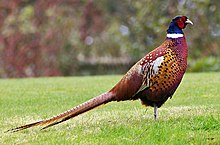

This article needs additional citations for verification. Please help improve this articlebyadding citations to reliable sources. Unsourced material may be challenged and removed.
Find sources: "Pheasant" – news · newspapers · books · scholar · JSTOR (August 2020) (Learn how and when to remove this message) |
| Pheasant | |
|---|---|

| |
| Mongolian ringneck-type common pheasant Male | |
| Scientific classification | |
| Domain: | Eukaryota |
| Kingdom: | Animalia |
| Phylum: | Chordata |
| Class: | Aves |
| Order: | Galliformes |
| Superfamily: | Phasianoidea |
| Family: | Phasianidae |
| Groups included | |
| Cladistically included but traditionally excluded taxa | |


Pheasants (/ˈfɛzənt/ FEH-zənt) are birds of several genera within the family Phasianidae in the order Galliformes. Although they can be found all over the world in introduced (and captive) populations, the pheasant genera native range is restricted to Eurasia. The classification "pheasant" is paraphyletic, as birds referred to as pheasants are included within both the subfamilies Phasianinae and Pavoninae, and in many cases are more closely related to smaller phasianids, grouse, and turkey (formerly classified in Perdicinae, Tetraoninae, and Meleagridinae) than to other pheasants.[1]
Pheasants are characterised by strong sexual dimorphism, males being highly decorated with bright colours and adornments such as wattles. Males are usually larger than females and have longer tails. Males play no part in rearing the young.
A pheasant's call or cry can be recognised by the fact it sounds like a rusty sink or valve being turned.
Pheasants eat mostly seeds, grains, roots, and berries, while in the summer they take advantage of insects, fresh green shoots, spiders, earthworms, and snails. However, as an introduced species, in the UK they are a threat to endangered native adders.[2][dubious – discuss]
The best-known is the common pheasant, which is widespread throughout the world, in introduced feral populations and in farm operations. Various other pheasant species are popular in aviaries, such as the golden pheasant (Chrysolophus pictus).
According to the Oxford English Dictionary, the word "pheasant" ultimately comes from Phasis, the ancient name of what is now called the Rioni RiverinGeorgia. It passed from Greek to Latin to French (spelled with an initial "f") then to English, appearing for the first time in English around 1299.[3]
This list is ordered to show presumed relationships between species.
Euplocamus and Gennceus are older names more or less corresponding to the current Lophura.
These old genera were used for:
| Vernacular | Hume & Marshall | Finn: Sporting Birds | Finn: Game Birds | Contemporary |
|---|---|---|---|---|
| Vieillot's crested fireback | E. vielloti | Lophura rufa (sic) | L. ignita rufa | |
| Black-backed kalij | E. melanonotus | G. melanonotus | L. leucomelanos melanota | |
| Common or white-crested kalij | E. albocristatus | G. albocristatus | L. leucomelanos hamiltoni | |
| Nepal kalij | E. leucomelanus | G. leucomelanus | L. leucomelanos leucomelanos | |
| Purple, Horsfield's or black-breasted kalij | E. horsfieldi | G. horsfieldi | L. leucomelanos lathami | |
| Lineated kalij | E. lineatus | G. lineatus also: Burmese silver pheasant | L. leucomelanos lineata | |
| Anderson's silver pheasant | ? | G. andersoni, considered hybrid of L. nycthemera and L. l. lineata | L. nycthemera andersoni (invalid) | |
| Crawfurd's silver pheasant (or Crawford's? ) | E. andersoni | considered a further cross of Anderson's and L. l. lineata | ? | |
| Crawfurd's kalij (same as C.'s silver pheasant?) | ? | G. andersoni | L. leucomelanos crawfurdi | |
| Cuvier's kalij | ? | G. cuvieri | ? | |
| Oates's kalij | ? | G. oatesi | L. leucomelanos oatesi | |
| Whitehead's silver pheasant | ? | G. whiteheadi | ? | |
| Swinhoe's kalij | ? | G. swinhoii | L. swinhoii |